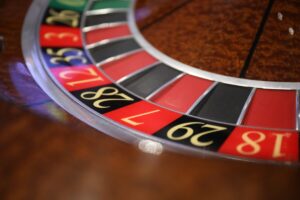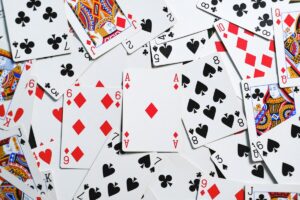 ‘Roulette’ is the diminutive form of the French word ‘rouelle’, meaning wheel and, although based on older games, was first referenced by its modern name in Bordeaux, in southwestern France, in the early eighteenth century. Roulette is played with a convex, solid wooden wheel with 37, 38 or – since the advent of so-called ‘triple zero’ roulette in 2016 – 39 red and black numbered pockets. A croupier spins the wheel in one direction and, while it is revolving, spins a small ball, colloquailly known as the ‘pill’, in the opposite direction around the running rail on the rim of the wheel. The roulette ball must complete at least three full rotations of the wheel.
‘Roulette’ is the diminutive form of the French word ‘rouelle’, meaning wheel and, although based on older games, was first referenced by its modern name in Bordeaux, in southwestern France, in the early eighteenth century. Roulette is played with a convex, solid wooden wheel with 37, 38 or – since the advent of so-called ‘triple zero’ roulette in 2016 – 39 red and black numbered pockets. A croupier spins the wheel in one direction and, while it is revolving, spins a small ball, colloquailly known as the ‘pill’, in the opposite direction around the running rail on the rim of the wheel. The roulette ball must complete at least three full rotations of the wheel.
Players bet on where the ball will come to rest by placing casino chips, or tokens, on a baize or felt-covered betting area, known as the ‘layout’, marked to correspond with the compartments of the wheel. So-called ‘inside’ bets include a ‘straight up’ bet, on a single number, a ‘split’ bet, on two adjacent numbers and a ‘street’ bet, on a row of three adjacent numbers. Alternatively, so-called ‘outside’ bets allow players to bet on the ‘type’ of number on which the ball will come to rest. Red/black and even/odd are the most basic outside bets, but other examples include ‘column’ and ‘dozen’ bets, which both cover twelve numbers apiece, depending on their position on the layout, or numerically.
 Blackjack, a.k.a. ‘twenty-one’, is a card game in which the aim is to outscore the dealer, or have the dealer ‘bust’ by having a points total exceeding twenty-one. The name ‘blackjack’ was derived from a bonus historically paid to players dealt the jack of spades or the jack of clubs and the ace of spades, but nowadays the term is used to describe any court card or ten and an ace, of any suit, dealt as the first two cards to a player during the game.
Blackjack, a.k.a. ‘twenty-one’, is a card game in which the aim is to outscore the dealer, or have the dealer ‘bust’ by having a points total exceeding twenty-one. The name ‘blackjack’ was derived from a bonus historically paid to players dealt the jack of spades or the jack of clubs and the ace of spades, but nowadays the term is used to describe any court card or ten and an ace, of any suit, dealt as the first two cards to a player during the game.
Blackjack is one of the most popular casino games in the world because it is easy to understand and offers a house edge of less than 1%, depending on the number of decks of cards – typically between one and eight – used in the game. Indeed, by using a set of rules, known as ‘basic strategy’, which describe the optimal way to play any hand, skilled players to reduce the house edge to around 0.5%.
In casino blackjack, before any cards are dealt, each player places one or more bets, depending on how many hands they wish to play at a time, in the designated area in front of them. Each player hand receives two cards, face down, while the dealer hand receives two cards, one of which, known as the ‘upcard’, is dealt face up. With the exception of blackjack, which outranks all other 21-point hands, the value of a hand is the sum of the individual cards; aces count as 1 or 11, court cards count 10 and all other cards count as face value.
Players may stand pat with their cards or draw one or more additional cards, but if total value of any hand exceeds 21, the hand ‘busts’ and the bet loses. Other options include doubling a bet, in return for one, and only one card, splitting a pair into two individual hands and surrendering a hand, which results in losing half, but only half, of the money staked on it.
 Craps is a gambling game played with two dice. The game was introduced to New Orleans by the French in the mid-nineteenth century, when it was originally known as ‘Crapaud’s dice’; historically, the nickname for any Frenchman was ‘Johnny Crapaud’ or ‘Johnny Toad’. In the meantime, craps has evolved to become arguably the most common game of its kind in the world.
Craps is a gambling game played with two dice. The game was introduced to New Orleans by the French in the mid-nineteenth century, when it was originally known as ‘Crapaud’s dice’; historically, the nickname for any Frenchman was ‘Johnny Crapaud’ or ‘Johnny Toad’. In the meantime, craps has evolved to become arguably the most common game of its kind in the world.
Craps is played on a dedicated table, typically 12′ long and surrounded by high walls, with rubber pyramids on the back wall to prevent so-called dice control, or precision control. A distinctive craps layout, showing all the various bets available, of which there are literally dozens, is stencilled onto the bed, or ‘floorette’, of the table. A craps table is supervised by a casino employee known as a ‘boxman’. Another employee, known as a ‘stickman’ calls out the roll and returns the dice to the player throwing them, a.k.a. the ‘shooter’, while one or more other employees, known as ‘dealers’, take the bets.
The game of craps is structured around a bet known as the ‘pass line’ bet, which pays 1/1 if successful and offers a competive house edge of just 1.41%. The first roll of the pass sequence is known as the ‘comeout’ roll. A comeout roll of 7 or 11 wins a pass line bet immediately, but 2, 3 or 12, a.k.a. ‘craps’, loses immediately. All other totals establish a target, or ‘point’, which the shooter must roll again before rolling a 7 for the pass line bet to win.
 Bingo, a.k.a. lotto, is a classic game in which players check off numbers on a physical, or electronic bingo card as they are called, at random, by a caller or host. The winner is the first player to complete a prescribed pattern, such as one, or two, horizontal rows, or all the numbers on the card, a.k.a. a ‘full house’.
Bingo, a.k.a. lotto, is a classic game in which players check off numbers on a physical, or electronic bingo card as they are called, at random, by a caller or host. The winner is the first player to complete a prescribed pattern, such as one, or two, horizontal rows, or all the numbers on the card, a.k.a. a ‘full house’.
Traditionally, so-called ‘cash bingo’ is played for cash prizes made up of a players’ stakes, minus playing fees, while so-called ‘prize bingo’ is played for prizes, of various forms, which are not directly to the number of players or players’ stakes. As far as casinos are concerned, neither form of bingo is particularly lucrative, but the social aspect of the game appeals to a wide demographic and its popularity endures.
Numerous variations of bingo exist, but the two most popular are 90-ball and 75-ball bingo, which take their names from the total number of balls in play. The 90-ball version is played with a bingo card consisting of a 9 x 3 grid, with 27 spaces in total, but only five spaces in each row contain numbers, so 15 numbers are in play. By contrast, the 75-ball version is played on a card consisting of a 5 x 5 grid, with 25 spaces in total; all the spaces contain numbers, with the exception of the centre square, which is desingated a ‘free’ space, so 24 numbers are in play.
